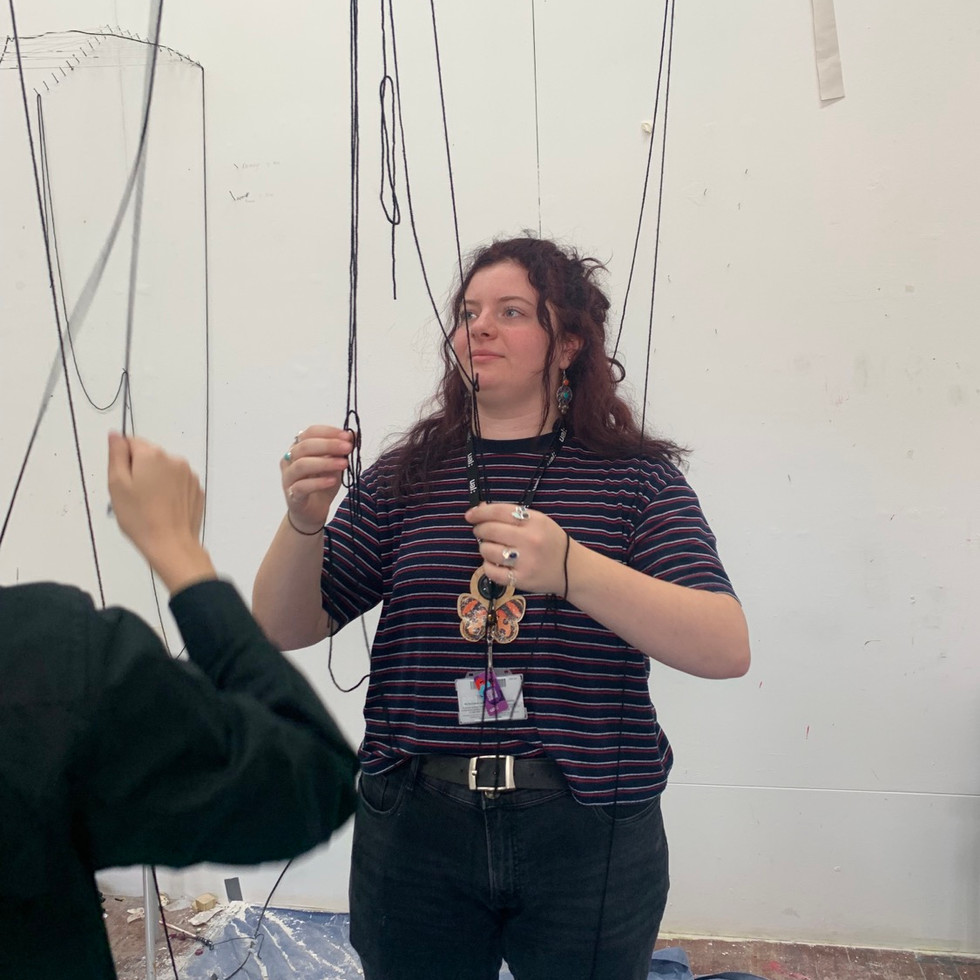‘SPACE INVADERS’ PROJECT REFLECTION
- Daisy Parkinson
- Jan 17, 2020
- 3 min read
This project so far has shifted my perspective on what the idea of ‘Sculpture’ really is. Beginning with a lecture on the different ways that sculpture artists have ‘invaded space’ through art, I have seen how sculpture in itself can be adapted to almost any form.
I began the project doing a series of collaborative works with colleagues. Invading space using string, performance arts, and filling space. Invading space with a material as simple as string had much more of an impact than I initially though. The studio space became a hazard to everyone it and the process of walking across the room, avoiding the works became a work in itself. We looked at invading personal space, by attaching string to ourselves and allowing ourselves to be controlled through this by others. This puppet like performance piece brought connotations of the restrictions of childhood and demonstrated an alternative way in which personal space can be invaded. Inspired by Andy Goldsworthy, we also created a large spiral in the car park of The CCW Foundation Centre, essentially invading the outdoor space.
For my individual development in this project, I initially considered creating a photography series on how people invade their own spaces through hoarding – as that is a big problem among artists. But I decided to develop an outcome into a less obvious way of interpreting the project. I then drew from this idea of clutter and decided to send an environmental message through the work. Looking at how our space and natural spaces are invaded by artificial materials such as plastic, I will use scrap/waste plastic to create pieces to them be used/worn. I began by creating a functional piece (a handbag) to work with basic shapes and forms to experiment with my chosen technique: crochet. Looking at the artists Helle Jorgensen and Mary Sibande, I have decided to make my design more abstract and explicit in the message I will convey to the audience. Sydney artist Jorgensen crochets plastic to depict coral structures that are very vibrant and organic looking. S. African artist Sibande combined a sculptural approach with fashion to communicate ideas of femininity and ‘blackness’ at Somerset house, I was influenced by her wearable designs bringing forward connotations of confinement and danger to me as a viewer. The vine like winding structure seemed comforting as well as having feelings of entrapment attached. The use of one colour: purple, for the entirety of some of her pieces, to her, was to depict ideas of uniform and family history of being maids for white families. I have decided to take forward this use of only one colour and adapt it to my concept. I have chosen to use solely white plastic for my final outcome, the colour that coral turns when it bleaches and dies. I have been primarily using wasted plastic medical aprons from dressing kits that would otherwise have gone to waste.
Using crochet to make this piece was more challenging than I expected. The textures of different plastics plays a A large role in how easy It is to crochet and how close together the stitching will be. For example a shinier and thicker plastic is a lot harder to crochet, leaving larger holes in the stitching. The range of white plastics I acquired during this project made the peace more interesting as there were different shades of white as well as different textures, making the piece as a whole varied within the constraints of a white colour scheme.
During the end of project group crit, it was great to see people engaged with my work and identifying it as bleached coral. Some said the piece looked very cellular and intricate, a piece that could be multiplied and expanded to fill a whole room. This helped me to see the potential that my work could reach if the project were to be continued. It didn’t seem obvious that the piece was made from plastic, which added a sense of unknown to the sculpture/headpiece. It was also suggested that I could create an stop frame animation from moving the parts of the sculpture individually, as if it was placed in an under-the-sea environment. Placing the sculpture in different natural environments and photographing it was also another idea for development. During the crit, I displayed the sculpture on a light wood coffee table, which for me didn’t hold much significance as the photo shoot I did for the piece was to show the way it was intended to be displayed. However it was suggested that placing it on a coffee table added much significance to the context and the concept of the piece. As coffee tables have connotations of talking, comfortable conversation, this made my creation a discussion piece; it made it an opportunity to highlight the problem of sea pollution to others.



































































































Comments